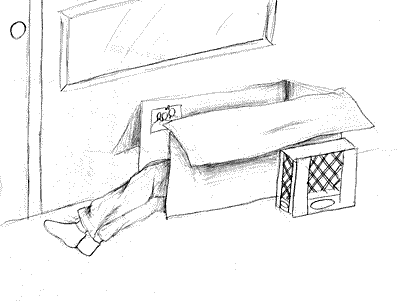All Nonfiction
- Bullying
- Books
- Academic
- Author Interviews
- Celebrity interviews
- College Articles
- College Essays
- Educator of the Year
- Heroes
- Interviews
- Memoir
- Personal Experience
- Sports
- Travel & Culture
All Opinions
- Bullying
- Current Events / Politics
- Discrimination
- Drugs / Alcohol / Smoking
- Entertainment / Celebrities
- Environment
- Love / Relationships
- Movies / Music / TV
- Pop Culture / Trends
- School / College
- Social Issues / Civics
- Spirituality / Religion
- Sports / Hobbies
All Hot Topics
- Bullying
- Community Service
- Environment
- Health
- Letters to the Editor
- Pride & Prejudice
- What Matters
- Back
Summer Guide
- Program Links
- Program Reviews
- Back
College Guide
- College Links
- College Reviews
- College Essays
- College Articles
- Back
Menstruation and Homelessness
Periods, oh that taboo word! For some, periods may seem like the first step to becoming a woman. For others, periods can be a nightmare. But, not all hope is lost. There are things that can make a woman's period more manageable.
First of all, there are necessities such as pads, tampons and menstrual cups that can make a woman’s period clean. Then, there are heating pads, pain relievers and hot showers, that can help ease the pain of menstrual cramps, a common side effect that is different for every woman.
These items can come in handy when it is that ‘time of the month’, but imagine if you couldn’t afford this necessities, if you couldn't manage your menstrual cycle, if you couldn't even keep yourself clean? What would you do? What could you do?
In 2016, there were about 217, 268 (39.5%) women living in homelessness. For some of these women, the act of getting their period was a struggle.
Homeless women struggle to afford the necessities that most women use to cope with their menstrual cycles. A simple package of tampons or pads can cost up to about 7 to 8. dollars. These items can be expensive, especially for a woman who can barely afford to buy a warm meal.
As a result, many homeless women roll up pieces of tissues, paper towels, toilet paper, or any piece of cloth that they can get their hands to use in place of a hygiene product. They even resort to stealing tampons or asking strangers for them.
Keep in mind that menstrual hygiene is very important. Improper material used in place of a hygiene product can potentially lead to severe infections, such as the Urinary Tract Infection (UTI). If not treated, this infection can be detrimental to the kidneys. A woman living in poverty should not have to fear for this.
Homeless women also struggle to clean themselves properly. Since hot showers are hard to come by, women living on the streets tend to use the sinks of public restrooms to keep themselves clean. Sinks are used to wash your hands, not to wash your body or stained clothes. A woman living in poverty should be able to shower with dignity.
You may be asking yourself: Why not go to a homeless shelter? Why not just stay there and get help? Sometimes a woman fears to. Some homeless shelters can be dangerous. For this reason, many women living in homelessness choose to keep away from them.
If it is safe, there could be bathroom restrictions. The homeless can be restricted to how many times they can use the restroom a day. If the average woman menstruates for 2 to 7 days, a woman should be able to use the bathroom more than once a day. These bathroom regulations need to be altered for women who are on their menstrual cycle.
Also, because the word ‘period’ can be seen as taboo, items like pads, tampons, and menstrual cups can be overlooked when donating to a homeless shelter. In fact, there are many homeless shelters that lack in supply of menstrual items. They are always in need of more. It can be challenging for them to provide menstrual hygiene products to all women with a limited supply.
Homeless women should be able to keep themselves clean and have easy access to a tampon. Menstrual hygiene products are essential for women. A woman on the streets should not have to feel ashamed of herself or embarrassed for not being able to cope with her period. A woman on the streets deserves to have a dignifying period, just like any other woman in the world. Periods are part of a woman's reproductive anatomy. They should not be ignored or neglected.
When donating, you should always consider feminine hygiene products. When donating, do not be hesitant to donate these womanly necessities. Women, regardless of socioeconomic status, should be able to maintain their feminine hygiene and live a healthy life- a healthy life starts with our donations.
Reference Page
Allen, S. (2016). The Fight to Give Homeless Women a Dignified Period. Retrieved April
19, 2017.
Farmer, Liz. Menstruating While Homeless: An Ignored, Inescapable Issue. Retrieved April 19, 2017.
Goldberg, E. (2015). For Homeless Women, Getting Their Period Is One Of The Most
Difficult Challenges. Retrieved April 19, 2017.
Henry, M., Watt, R., Rosenthal, L., & Shivji, A. (2016) The 2016 Annual Homeless Assessment
Report. Hudex Change. Retrieved
April 19, 2017.
McIntosh, J. (2017). Urinary Tract Infection: Causes, Symptoms, and Treatments. Retrieved April 21,
2017.
Menstruation and the menstrual cycle. (2017). Retrieved April 21, 2017.
RN, Blacksberg, M. (2016). What It's Like to Be Homeless and on Your Period. Retrieved April 19,
2017.
Upadhye, J. (2016). This Is How Homeless Women Cope With Their Periods. Retrieved
April 19, 2017.

Similar Articles
JOIN THE DISCUSSION
This article has 0 comments.

I enjoy helping others and the community.